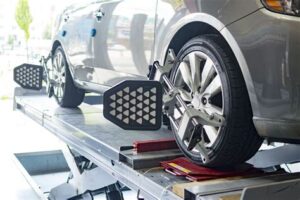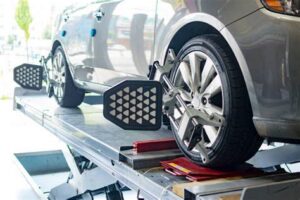Discover the symptoms of off-center steering, uneven tire wear, and how to diagnose handling issues with professional alignment inspection tips.Is your drive feeling less smooth than it used to? Car alignment plays a crucial role in ensuring a safe and comfortable driving experience. When your vehicle’s alignment is off, it can lead to a range of problems that can compromise your safety and increase wear and tear on your tires. In this blog post, we will delve into the key symptoms that indicate your car’s alignment might be off, including off-center steering and uneven tire wear. We’ll guide you through checking your steering wheel position, diagnosing handling issues, and knowing when it’s time to seek a professional alignment inspection. By understanding these signs, you can keep your vehicle running smoothly and extend the life of your tires. Let’s get started!
Symptoms of Off-Center Steering
One of the most common signs that your car’s alignment may be off is experiencing off-center steering. This condition occurs when the steering wheel does not sit straight, even when driving on a level road. Understanding the symptoms associated with off-center steering can help you identify potential alignment issues before they escalate.
Some typical symptoms of off-center steering include:
- Steering Wheel Misalignment: The steering wheel may be tilted to one side while driving straight.
- Pulling to One Side: The vehicle may drift or pull towards one direction, requiring constant correction.
- Vibration in the Steering Wheel: You may notice an unusual vibration while driving, which can indicate problems with the alignment.
Neglecting these symptoms can lead to more severe handling and safety issues, so it’s essential to pay attention to your vehicle’s behavior. Regular inspections can help ensure your vehicle’s alignment and steering components are in optimal condition.
Uneven Tire Wear
Uneven tire wear is a prevalent symptom of poor car alignment. When your vehicle’s wheels are not aligned properly, it can lead to excessive wear on specific areas of the tire, ultimately affecting your vehicle’s performance and safety.
The most common types of uneven tire wear include:
- Camber Wear: This occurs when the wheels tilt too much inward or outward, leading to wear on one side of the tire.
- Toe Wear: If the wheels point inwards or outwards, the tires will wear more on the inner or outer edges, respectively.
- Center Wear: This can happen due to over-inflation, causing the center of the tire to wear faster than the edges.
Regularly checking your tires for uneven wear patterns can help you identify alignment issues before they lead to more significant problems. If you notice any signs, consider getting a professional assessment of your vehicle’s alignment as soon as possible.
Checking Steering Wheel Position
One of the most critical aspects of ensuring your vehicle’s alignment is to check the steering wheel position. An improperly aligned steering wheel can lead to a host of driving issues, including discomfort and difficulty in handling the vehicle. Understanding how to correctly assess the steering wheel position can save you from more significant problems down the road.
To check the steering wheel position, follow these steps:
- Drive your vehicle on a flat, straight road at a steady speed.
- Observe the steering wheel closely. Is it aligned straight ahead or does it seem to tilt to one side?
- Take note of any pulling tendencies; does the car drift to the left or right unintentionally?
If you find that your steering wheel is off-center while driving straight, it’s a clear indication that your vehicle’s alignment may be misconfigured. This could lead to uneven tire wear and further handling issues if not addressed promptly.
Diagnosing Handling Issues
When it comes to vehicle safety and performance, handling issues can be a clear indicator that your car’s alignment might be off. If you’re experiencing any of the following symptoms, it’s crucial to take your car for a thorough inspection. The earlier you catch these issues, the better it is for your vehicle’s longevity and your safety.
Common symptoms of poor handling can include:
- Pulling to one side while driving
- Wandering or feeling unstable on the road
- Excessive vibration in the steering wheel
- Steering feels loose or requires constant correction
- Increased difficulty when making turns
To properly diagnose these handling issues, you should consider the following steps:
- Visual Inspection: Check the tires for uneven wear or any visible damage.
- Road Test: Drive your vehicle to assess how it feels, paying attention to any of the symptoms mentioned.
- Professional Evaluation: If you suspect any alignment or suspension issues, it’s best to consult a professional mechanic. They can perform the required tests and give an accurate diagnosis.
Properly diagnosing handling issues not only helps in maintaining your car’s performance, but it also enhances your safety on the road. If any symptoms arise, don’t delay in taking action!
Professional Alignment Inspection
A professional alignment inspection is a crucial step in maintaining your vehicle’s optimal performance. When your car’s wheels are improperly aligned, it can lead to a myriad of issues, including uneven tire wear, poor handling, and compromised safety. By seeking the expertise of a certified technician, you can ensure that your vehicle is aligned according to manufacturer specifications.
During a professional alignment inspection, technicians utilize specialized equipment to assess the three main angles of wheel alignment: camber, caster, and toe. Each of these angles plays a pivotal role in your vehicle’s steering and tire performance. Here’s a brief overview of what each angle entails:
| Alignment Angle | Description |
|---|---|
| Camber | The angle of the wheel in relation to the road; affects tire wear and handling. |
| Caster | The angle of the steering axis; influences steering stability and road feel. |
| Toe | The direction the tires point relative to the centerline of the vehicle; can impact tire wear and traction. |
After the inspection, the technician will provide a detailed report on the alignment status and recommendations if adjustments are necessary. This ensures that your vehicle runs smoothly and effectively, ultimately extending the lifespan of your tires and enhancing road safety.
Regular professional alignment inspections are integral to maintaining vehicle health. Ignoring alignment issues can lead to costly repairs and a decrease in fuel efficiency, making it vital to prioritize
Frequently Asked Questions
What are the common signs that indicate my car’s alignment might be off?
Common signs of misalignment include uneven tire wear, the steering wheel being off-center, pulling to one side while driving, and a crooked steering wheel when driving straight.
How can I check the alignment of my car myself?
You can check your car’s alignment by observing tire wear patterns, using a tape measure to compare the distance between the front and rear tires, and by ensuring the steering wheel is centered while driving on a straight road.
What causes misalignment in vehicles?
Misalignment can be caused by hitting potholes, curbs, or speed bumps too hard, regular wear and tear, and uneven tire pressure in the tires.
How often should I have my car’s alignment checked?
It’s advisable to have your car’s alignment checked at least once a year, or whenever you notice unusual tire wear or after any severe impact incidents like hitting a curb.
Can misalignment affect my car’s fuel efficiency?
Yes, misalignment can negatively impact fuel efficiency as it forces the vehicle to work harder to travel straight, leading to increased fuel consumption.
What is the difference between alignment and balancing?
Alignment refers to the adjustment of the angles of the wheels to ensure they are in a straight line and working properly with the suspension, while balancing involves equalizing the weight of the tire and wheel assembly to ensure a smooth ride.
Is it safe to drive a car with misaligned wheels?
Driving with misaligned wheels can be unsafe, as it affects vehicle handling, increases tire wear, and can lead to accidents if the car pulls unexpectedly.





